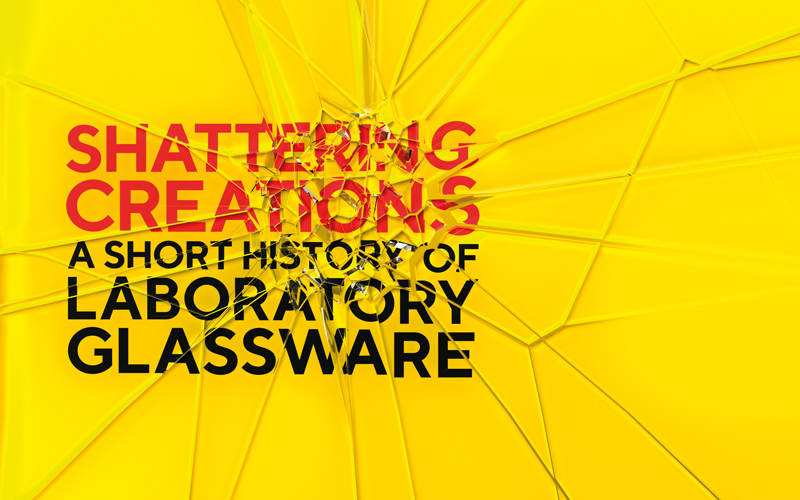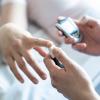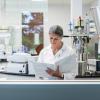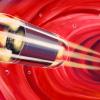Specialist Biomedical Scientist Stephen Mortlock looks at the development of lab glassware, from early experiments and alchemy to the classic designs throughout the ages.

At a glance
- The earliest examples of “scientific” glassware come from Hellenistic Egypt from 323 BC to 30 BC.
- There are various versions of the scientific beaker, but one of the most popular is the Griffin beaker, invented by John Joseph Griffin.
- Biological research has evolved from hands-on wet chemistry using glassware and manual techniques to sophisticated instrumentation and plastic disposable labware.
In old horror films there is often a scene (or two) that shows the audience an evil character working in his laboratory – typically a refurbished dungeon of some sort, with ageing, dripping-wet stone walls covered in algae.

The laboratory will generally feature some, or all, of the following laboratory equipment:
- An operating table. An extra table is always needed if the scientist does brain transplants.
- A big Jacob’s Ladder (the thing that looks like an old-fashioned TV aerial with an electrical arc between the posts), more formally known as a high-voltage travelling arc.
- A Tesla coil shooting out colourful corona discharges, brush discharges and streamer arcs.
- A 1960s-style mainframe computer with big dials and switches on the front. If there are spinning tape reels so much the better!
- Big chalkboards filled with complicated equations, indecipherable diagrams and abstruse symbols.
- Dusty piles of incomprehensible failed experiments, folders and books that the scientist will rummage through trying to find the solution to a problem.
- An oscilloscope displaying a Lissajous pattern.
Alongside these there will also be an array of glassware and equipment, especially test tubes, beakers and flasks of bubbling liquid, distilling columns, condensers, burettes, and Bunsen burners, all connected together to form impressive glass sculptures, seemingly inspired by pictures of the 1952 classic Miller–Urey experiment. Modern laboratories, however, have very little use for much of the glassware shown in the films, but it is a necessary signifier otherwise the audience won’t realise that “science stuff” is happening. Although some of the laboratory apparatus frequently shows up in period settings that predate their invention, it should be remembered that glassmaking is a very old technology with glass artefacts being found in Syria that are 4500 years old. Professor Seth Rasmussen, a science historian from North Dakota State University, hypothesised that the process of making glass was discovered as a by-product of metallurgy – extracting metals from their ores at high temperatures. These ores, which are found in rocks, often contain silicates, just like glass. During the smelting process for copper, the metal can be extracted from malachite [a green copper carbonate hydroxide (Cu2(CO3)(OH)2) mineral] using charcoal as a reducing agent at high temperatures. This results in a mixture of molten metal and a waste layer known as “slag”. The layers of slag and molten metal are immiscible: the metal layer is denser, and the lighter slag layer can be scooped off the top. When the slag cools, the result is a glassy blue or green solid. In ancient Egypt this slag was chipped away to make glassware products, jewellery and even ground into powder to add to glazes for use in ceramics.
John Parker, Professor Emeritus of Glass Science and Engineering at the University of Sheffield, says “Aleppo in Syria was the birthplace of glassmaking as we know it and went on to become a famous glassblowing centre following the invention of the blowpipe.” When Syria was annexed by the Roman Empire in 64 BC, these skills were rapidly shared and the next step came in 1500 BC, with the first hollow glass containers. Marco Beretta saw Constantinople as the place where experimentation with new techniques of glassmaking used elsewhere evolved and with that the evolution of alchemy as the production of glass was steeped in a veil of protective secrecy about the nature and production of glass. New ideas started to filter back to the west and Torcello in Italy became a centre for fine glassware in the 8th century, creating stained glass for the new church architecture. But eventually the veil of secrecy was pulled back when Pierre Loysel (1606-1679) in his Essai sur les principes de l’art de la verrerie (Essay on the Principles of the Art of Glassware) stripped away those secrets and proclaimed a new beginning,
Scientific glassware
The earliest examples recognisable as “scientific” glassware come from the alchemists’ laboratories of Hellenistic Egypt from 323 BC to 30 BC. These early experimentalists prized glass for being inert and transparent, making it the natural choice for conducting their experiments. Alchemy was seen as a protoscientific stew of chemistry, astrology, mysticism, metallurgy, physics and religion. Its practitioners have been depicted as both cosmic clowns and demonic dabblers, but that is a modern perspective on the alchemists of medieval and Renaissance Europe who were at the time considered learned men of science. The alchemist Maria/Mary Hebraica, who lived in the 1st century, is credited with the invention of the tribikos – a kind of alembic with three arms used to obtain substances by distillation. Contemporary records by Zosimos of Panopolis (3rd to the 4th century AD) show that Mary found glass items useful because they allowed the reactions to be viewed without disturbing them. Mary’s name survives in her invention of the bain-marie (Mary’s bath), which limits the maximum temperature of a container and its contents to the boiling point of a separate liquid (which is very good for melting chocolate).

Antonio Neri (1576–1614), a priest and researcher of the time, was well known for his glassmaking manual L’arte vetraria. His manuscripts and drawings describe not only the glass instruments used in the lab but also the alchemical processes, such as distillation, sublimation, calcination and melting. The 17th century alchemist Johann Glauber (1604–1670) was also a prominent figure and promotor of glassware for experimentation. His knowledge of raw materials and their purification proved indispensable and an essential part of the development of glass in the Baroque era. He was able to colour glass, using metal and achieved green glass with copper, blue with cobalt, yellow with iron, purple with manganese and red with colloidal gold. Glassware and alchemy also show up in art; a painting by the Flemish Baroque painter David Teniers (1610–1690) shows a bearded alchemist sitting in a bustling workshop, tending a small brazier of coals with hand-bellows. Glass vessels for distillation and small apothecary jars with cloth lids can be seen alongside instruments for metalworking – including an anvil, crucible, a furnace and hammer amongst the general clutter of the laboratory.
In the 1800s, however, a few German universities were developing a new type of lab, at first in Germany and then across the world by the end of the century.
This revolution in lab design was essentially the chemistry laboratory that would be recognised today. It consisted of (and in many places still does) rows of polished wood benches with storage above and drawers and cupboards beneath. The benches were all fitted with piped gas and running water and occasionally vacuum taps. There was drainage to take all the liquid waste to mains sewage. Due to the nature of much of the testing being performed there were fume cupboards to limit the exposure of noxious fumes. From the 1800s, detailed descriptions of laboratories also appeared in scientific journals.

Besides floor plans, such descriptions often presented various views, cross-sections and drawings of individual details, such as experimentation tables, cupboards or darkening facilities in the lecture theatre. From the end of the 1880s, similar depictions can also be found in construction journals and architecture handbooks. The foundation of the Friedrich Wilhelm University in Berlin (1810) quickly attained international renown and contributed to a dynamically expanding and widely distributed system of laboratories. Initially set up and directed by highly motivated university teachers on their own initiative, some of these private laboratories quickly developed a strong pulling power and were then integrated into the reformed universities.
Laboratory equipment
Dedicated laboratory equipment did not truly exist prior to the early 1800s and even then would have been primitive, bearing little resemblance to familiar modern glassware. And much chemistry was done with whatever bowls and jars were already available. Other equipment (such as alembics) was made of metal. In the 1800s Jöns Jacob Berzelius (1779–1848), one of the founders of modern chemistry, had a passion for scientific experimentation and developed specialist chemistry lab equipment. He invented improved methods of chemical analysis that enabled him to demonstrate the differences between compounds. In 1802 Berzelius graduated as a physician, but he still wanted to continue to study and experiment with chemistry and so he learned the skills of glassblowing to allow him to make new equipment to develop experiments.

Beakers: Who would have thought that a primitive Neolithic people would become synonymous with a standard piece of laboratory equipment – the beaker. So named after the Beaker people (2500-1700 BC) who were master pottery makers and are thought to have created a particular style of pottery in northwestern and central Europe. The modern equivalent is a simple cylindrical container usually made from glass to store, heat and mix liquid, with a lip around the top for easy pouring and to prevent spills and with a flat surface on the bottom. There are various versions of the scientific beaker but one of the most popular is the short-form version, which is also known as the Griffin beaker, invented by John Joseph Griffin (1802–1877) who did much to introduce scientific methods and popularise the study of chemistry. His first book, published in 1823, Chemical Recreations: a popular manual of experimental chemistry, was highly successful and became a handbook for many chemists. There is also a different type of beaker, which is tall and narrow, called a Berzelius beaker after Berzelius.

Erlenmeyer flasks: In 1860 Richard August Carl Emil Erlenmeyer (1825–909), described his new glass flask as having a cylindrical neck, a conical body, and a flat bottom. Compared to other beakers, the Erlenmeyer flask was a revelation with a narrower neck and a more tapered body. The narrow top could be easily sealed with a stopper to decrease evaporation and leakage while the sloping sides make it ideal for stirring, as it prevents the liquids from spilling out. These sloping sides also lessen the evaporation of liquids during heating, as the vapours will condense on the sides of the flask. Erlenmeyer flasks are also well suited for heating, thanks to their flat bottoms, which can be safely placed on a heater and won’t tip over unlike the round-bottom flasks also created by Erlenmeyer. Round-bottom flasks have round bodies and round bottoms. They are only able to rest upright on a flat surface with the help of either stabilising rings that the bottom of the flask rests within, or stand clamps secured to their necks. Because of the thermal shock they must endure during heating and distillation, round-bottom flasks are normally made of heat-resistant borosilicate glass.
Bunsen burner: So, we have the beaker or flask to store the liquid in, how are we going to heat it up? Step forward Robert Wilhelm Eberhard Bunsen (1811–1899), a German chemist, and Peter Desaga (1812–1879), a German instrument maker at the University of Heidelberg. They perfected their burner from an earlier design of Michael Faraday’s (1791–1867) laboratory burner, as described in the 1827 edition of his book Chemical Manipulations. They increased the length but decreased the width of the metal tube that made up the regular laboratory burner. This allowed the gas and air to mix before issuing out of the top of the tube where it could be lit safely without the flame propagating down the tube and eliminating the need of a wire safety screen. This new burner produced a virtually colourless, soot-free, flame of constant size. In 1857 Bunsen and the British chemist Henry Enfield Roscoe (1833–1915) published a paper on the establishment of photometric standards and the consistency of the new burners’ flame was perfect for their experiments.

The Leibig condenser: We have all seen films that show a clear droplet falling into a beaker from a Leibig condenser, this can either be the villain’s dastardly concoction for world domination, or the benevolent scientist’s universal cure. The condenser is used to cool and condense a gas back to a liquid, often as part of the process of chemical distillation. The apparatus consists of a straight glass tube through which the gas travels surrounded by a water jacket that helps to cool the gas. This type of condenser is named after the German chemist Justus von Liebig (1803–1873), but he only perfected and popularised the water-cooled condenser – records suggest it was invented in 1771 by the Swedish-German chemist Christian Weigel (1748–1831). To make things even more complicated, an anonymous pamphlet published in 1781 claimed that a counter-current condenser had been conceived in 1770 and tested in 1773. Illustrations in the pamphlet certainly show what would be considered a counter-current condenser in which cold water flowed from the condenser’s lower end to its upper end. Liebig himself incorrectly attributed the design to the German pharmacist Johann Friedrich August Göttling (1753–1809), who was a former student of Weigel. And we must not forget Pierre-Isaac Poissonnier (1720–1798), a physician to King Louis XV of France who published a design of a still that is remarkably similar to a counter-current condenser in 1779.
Folin-Wu tubes: In 1919 Otto Folin (1867–1934) and Hsien Wu (1893–1959) published a new method for determination of glucose, but this was criticised by other chemists who believed that there was excessive and uncontrollable reoxidation of cuprous oxide, leading to low values of blood sugar in their samples. This was a known phenomenon where cuprous compounds produced by sugar in alkaline copper solutions showed a marked tendency to be reoxidised to the cupric condition when exposed to air. To counter this, one year later they published a follow-up paper that showed a Folin-Wu tube that had a constricted portion of the test tube to avoid reoxidation of cuprous oxide by atmospheric oxygen providing the surface of the alkaline mixture of sugar and copper reached the constricted part.
Kipp gas generator: So, what do you do when the piece of apparatus you are using does not quite fit the experiment? You design your own, of course. In 1842 Petrus Jacobus Kipp (1808–1864), a Dutch pharmacist, was researching the presence of arsenic in livers and kidneys in rabbits and had to generate hydrogen. He used an apparatus designed in 1836 by the English Scientist James Marsh (1794–1846), but was unhappy with the design because hydrogen production could not be easily stopped during the experiments. So, in 1844, Kipp published his own designs for two simple gas generators that were made for him by the master German glassblower Heinrich Geissler (1814–1879) in the Tijdschrift voor Handel and Nijverheid (Journal for Trade and Industry). His first version was very fragile, so after a few modifications together they created an improved design, which became the model for all future versions of the Kipp apparatus.
Pasteur flask: French chemist Louis Pasteur’s (1822–1895) investigations into fermentation and the causes of disease laid much of the groundwork for the establishment of the science of bacteriology in the second half of the 19th century. But he also developed unique glass flasks for growing and studying bacteria that became standard tools in bacteriology labs.

Pasteur conducted a now infamous experiment in which he used a glass flask with an S-shaped neck. The shape of the flask was an integral part of Pasteur’s discovery. He partly filled the body of the flask with an “infusion” - a nutrient-rich broth. He then boiled the infusion, killing any germs already present in the liquid (pasteurisation), and since the swan neck prevented airborne organisms re-entering the flask, the infusion remained sterile.
Schlenk flask: Wilhelm Johann Schlenk (1879–1943) was a German chemist who discovered organolithium compounds and organomagnesium halides, which participate in complex chemical equilibrium reactions, now known as a Schlenk equilibrium. But Schlenk developed new techniques to handle air-sensitive compounds, resulting in the invention of the Schlenk flask. This is a reaction vessel with a side arm fitted with a PTFE or ground-glass stopcock; this allows the vessel to be evacuated or filled with gases (usually inert gases like nitrogen or argon). These flasks are often connected to Schlenk lines, which allow both operations to be done easily.
The orphans: But it is not always simple to find out who invented a particular piece of glassware. In an 1831 German textbook about chemical operations and apparatus, it describes “an oval glass vessel with bottle-like neck, and a glass stopper ending in a narrow tube”, the “Scheidetrichter” or a separatory funnel.
A separatory funnel, also known as a separation funnel, is a piece of laboratory glassware used in liquid–liquid extractions to separate the components of a mixture into two immiscible solvent phases of different densities. It looks like someone would have had a particular purpose for this piece of apparatus, but it seems that the present separatory funnel is the result of slow development in chemistry and untraceable to a single chemist or inventor.
Conclusions
The journey from the laboratoriums of alchemists and apothecaries through the innovation of the 17th century Italian physical and chemical laboratories, botanic gardens, anatomical theatres and dissecting rooms to the modern-day laboratories has been long and eventful, but has helped to define our understanding of scientific practice. The scientific and technological advancements of the early modern period were the outcome of great experimenters (Spallanzani, Pasteur and Jansen), as well as some ingenious craftsmen who aimed to find practical solutions to their questions. A crucial, yet often overlooked, role in this process was played by the wide array of specialised apparatus and technical equipment employed in their laboratories, which ultimately made these efforts possible. Glass was a key material that enabled the production of new ideas; it was versatile and could be shaped with relative ease to make bespoke apparatus. It can withstand high temperatures and strong chemicals and, most importantly, it is transparent, which is a key advantage for conducting experiments. But biological research has evolved from hands-on wet chemistry using elaborate glassware and manual techniques toward increasingly sophisticated instrumentation and plastic, disposable labware. Robotic automation can now perform manual, repetitive, dull and/or dangerous jobs, while single-use systems have become commonplace. This can leave laboratory personnel more time to focus on creative and innovative tasks, such as research, or guaranteeing the quality of tests, improving the quality of the service and an increased focus on health and safety, regulatory compliance, and transparency in the workplace.

Many years ago, I was interviewed by the science journalist from a local newspaper for an article on the Churchill Fellowship, and she wanted a picture of me holding and gazing intently into a test tube filled with a coloured liquid. I had to explain that I would be hard-pressed to find a test tube and, more importantly, most of my day was spent staring at a computer screen interpreting data being produced by a thermal cycler. But this was her image of a “scientist”. In the end we settled for a picture of me sitting in front of a whiteboard dotted with some “hopefully” intelligent-looking equations.
Explore further
- Biomedical Scientist article on the history of the test tube bit.ly/3Kr0kV1
- Biomedical Scientist article on the history of the petri dish bit.ly/3KoyDwl
- Science Museum content on the history of glassware in labs bit.ly/3Ray3Gc
Image Credit | Shutterstock | iStock | Science Photolibrary | Alamy
References
Marco Beretta, 'Between Nature and Technology: Glass in Ancient Chemical Philosophy' in When Glass Matters: Studies in the History of Science and Art from Graeco-Roman Antiquity to Early Modern Era, 2004
Seth C Rasmussen, How Glass Changed the World: The History and Chemistry of Glass from Antiquity to the 13th Century, 2012
Morris PJT. The history of chemical laboratories: a thematic approach. ChemTexts. 2021;7(3):21. doi: 10.1007/s40828-021-00146-x. Epub 2021 Jun 22. PMID: 34178581; PMCID: PMC8218977.
Ambade VN, Sharma YV, Somani BL. Methods for estimation of blood glucose : a comparative evaluation. Med J Armed Forces India. 1998 Apr;54(2):131-133.
Schmidgen H. ‘History of the Beginnings of the Laboratory in the Early Modern World.’ Brewminate (2018) February Edition.
Thomas M Annesley, We Know Folin, But Who Was Wu?, Clinical Chemistry, Volume 66, Issue 12, December 2020, Pages 1577–1578
Randles FS, Grigg WK. ‘Estimation of blood sugar by the Folin-Wu method: using 0.1 c.c. of blood.’ JAMA. 1924;82(9):684–686
Folin O & Wu H. ‘A system of blood analysis. Supplement I. A simplified and improved method for determination of sugar.’ J. Biol. Chem., xli (1920), p. 367- 374
Szabadvary F. ‘The history of chemical laboratory equipment’. Invited lecture delivered at the XVlIth International Congress of History of Science, Berkeley, USA, 5 August 1985
Ping-Yü, H., & Needham, J. (1959). The Laboratory Equipment of the Early Mediæval Chinese Alchemists. Ambix, 7(2), 58–112. https://doi.org/10.1179/amb.1959.7.2.58
Alan F. Donnelly, The Romantic History of Laboratory Glassware, Laboratory Medicine, Volume 1, Issue 3, 1 March 1970, Pages 28–33.
Jackson, Catherine M. “The ‘Wonderful Properties of Glass’: Liebig’s Kaliapparat and the Practice of Chemistry in Glass.” Isis, vol. 106, no. 1, 2015, pp. 43–69. JSTOR,
Miller, George L., and Catherine Sullivan. “Machine-Made Glass Containers and the End of Production for Mouth-Blown Bottles.” Historical Archaeology, vol. 18, no. 2, 1984, pp. 83–96. JSTOR
Marcos Martinón-Torres, Thilo Rehren & Sigrid von Osten. 2003. A 16th century lab in a 21st century lab: archaeometric study of the laboratory equipment from Oberstockstall (Kirchberg am Wagram, Austria). Antiquity Project Gallery 77(298):
Olalde, I., Brace, S., Allentoft, M. et al. The Beaker phenomenon and the genomic transformation of northwest Europe. Nature 555, 190–196 (2018).
Historic England 2022, Science Laboratories to 1900. Swindon.
Armstrong EF. ‘History of Laboratory Apparatus.’ Nature (1940); 146: 604
Jensen WB. ‘The Origin of the Bunsen Burner.’ J. Chem. Educ., 2005, 82, 518
R. Bunsen, H. E. Roscoe, “Photochemische Untersuchungen,” Poggendorff’s Ann. Chem. Phys., 1857, 100, 43 - 88. Reprinted in W. Ostwald, M. Bodenstein, Eds., Gesammelte Abhandlungen von Robert Bunsen, Vol. 3, Engelmann: Leipzig, 1904, pp. 19-56, and in W. Ostwald, Ed., Photo-chemische Untersuchungen von R. Bunsen und H. E. Roscoe (1855-1859), Erste Hälfte, Die Klassiker der exakten Wissenschaften, Nr. 34, Engelmann: Leipzig, 1892.
A review of the history of laboratory distillation, Editor(s): Erich Krell, Techniques and Instrumentation in Analytical Chemistry, Elsevier, Volume 2, 1982, Pages 20-31
Pinkowski J. ‘The Alchemist's Lab.’ ARCHAEOLOGY. (2004) Volume 57 Number 6.
Marco Beretta, The Alchemy of Glass: Counterfeit, Imitation, and Transmutation in Ancient Glassmaking. Sagamore Beach: Science History Publications/USA, 2009
Loibl W. ‘Johann Rudolph Glauber and the "glassy" consequences.’ January 2007
Journal of Glass Studies 49:81-101+289
Hongjiao Ma, Julian Henderson, Jianfeng Cui, Kunlong Chen. Glassmaking of the Qing Dynasty: A Review, New Data, and New Insights. Advances in Archaeomaterials. Volume 1, Issue 1. (2020). Pages 27-35,
Humphries, A.L. “Maria the Jewess.” Notes and Queries, S12 no. 8 (1916): 151–152.
Bunge, Mario (1983). Epistemology & Methodology II: Understanding the World. Treatise on Basic Philosophy. Vol. 6. Dordrecht: Reidel. doi:10.1007/978-94-015-6921-7. ISBN 90-277-1634-X. OCLC 9759870
Plebani M. The changing face of clinical laboratories. Clin Chem Lab Med. 1999 Jul;37(7):711-7. doi: 10.1515/CCLM.1999.109. PMID: 10510727.
Veronesi U, and Martinón-Torres M. ‘Glass and alchemy in early modern Europe: An analytical study of glassware from the Oberstockstall laboratory in Austria.’ https://www.researchgate.net/publication/322663920_Glass_and_Alchemy_in_Early_Modern_Europe_An_Analytical_Study_of_Glassware_from_the_Oberstockstall_Laboratory_in_Austria [accessed May 30 2024].
Mortlock S. ‘Spallanzani and Spontaneous Generation.’ The Microbiologist (2016): 17: 26-29




